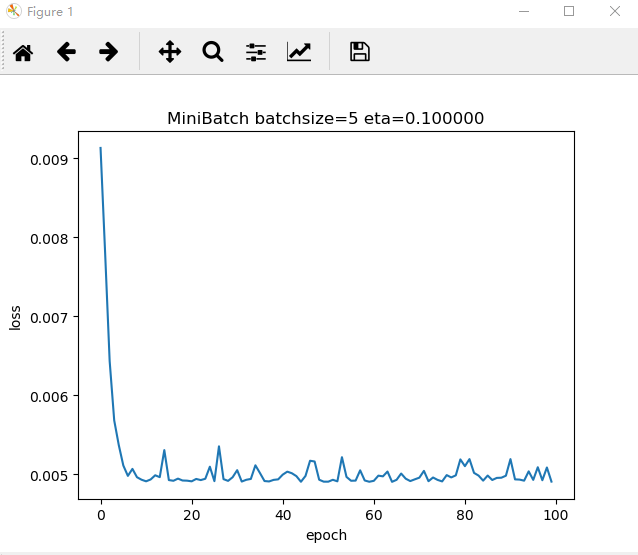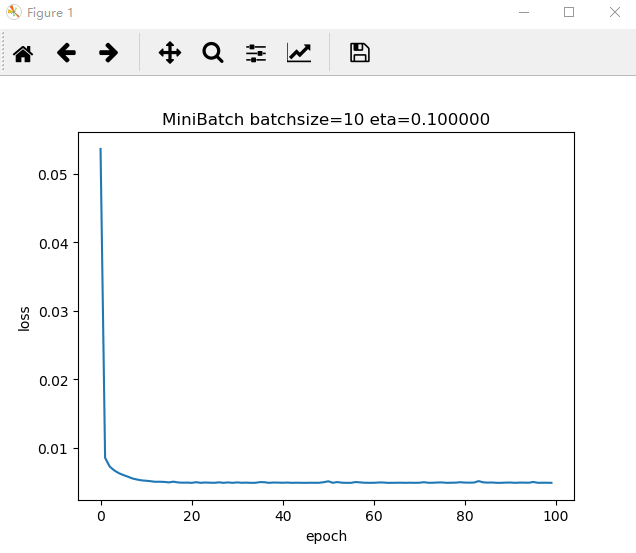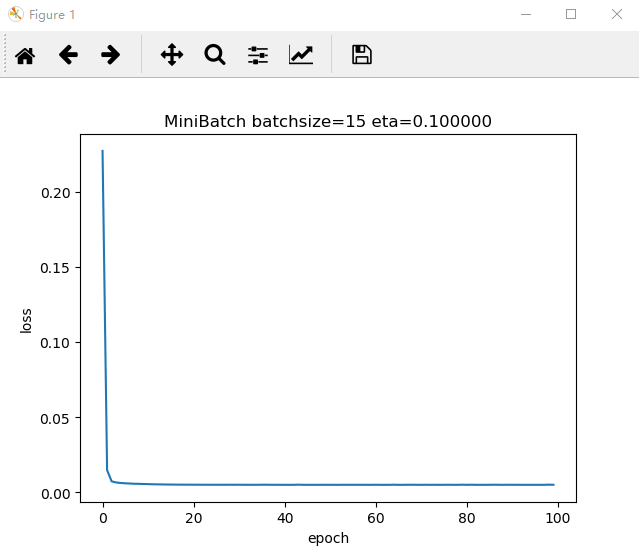使用minibatch的方式进行梯度下降
作业要求
| 项目 | 内容 |
|---|---|
| 课程 | 人工智能实战2019 |
| 作业要求 | 采用随机选取数据的方式,batch size分别选择5,10,15进行运行,并回答关于损失函数的 2D 示意图的问题 |
| 我的课程目标 | 掌握相关知识和技能,获得项目经验 |
| 本次作业对我的帮助 | 理解神经网络的基本原理,并掌握代码实现的基本方法 |
| 作业正文 | 【人工智能实战2019-何峥】第3次作业 |
| 其他参考文献 | 梯度下降的三种形式 参考代码 ch04/level4-final |
作业正文
1. 采用随机选取数据的方式,batch size分别选择5,10,15进行运行。画出Loss图。
import numpy as np
import matplotlib.pyplot as plt
from pathlib import Path
import random
x_data_name = "D:\VSCODEPROJECTS\AI_py\TemperatureControlXData.dat"
y_data_name = "D:\VSCODEPROJECTS\AI_py\TemperatureControlYData.dat"
def ReadData():
Xfile = Path(x_data_name)
Yfile = Path(y_data_name)
print(Xfile)
if Xfile.exists() & Yfile.exists():
X = np.load(Xfile)
Y = np.load(Yfile)
return X.reshape(1,-1),Y.reshape(1,-1)
else:
return None,None
def ForwardCalculationBatch(W,batch_x,B):
Z = np.dot(W,batch_x) + B
return Z
def BackwardCalculationBatch(batch_x,batch_y,batch_z):
k = batch_y.shape[1]
dZ = batch_z-batch_y
dW = np.dot(dZ,batch_x.T)/k
dB = dZ.sum(axis=1,keepdims=True)/k
return dW,dB
def UpdateWeights(dW,dB,W,B,eta):
W = W - eta*dW
B = B - eta*dB
return W,B
def RandomSample(X,Y,batchsize):
batch_x = np.zeros((1,batchsize))
batch_y = np.zeros((1,batchsize))
for i in range(batchsize):
if X.shape[1]==0:
print("wrong")
break
else:
r=random.randint(0,X.shape[1]-1)
batch_x[0,i] = X[0,r]
X = np.delete(X,i,axis=1)
batch_y[0,i] = Y[0,r]
Y = np.delete(Y,i,axis=1)
return batch_x, batch_y
def InitialWeights(n,f):
W = np.zeros((n,f))
B = np.zeros((n,1))
return W,B
def GetLoss(W,B,X,Y):
Z = np.dot(W, X) + B
m = X.shape[1]
Loss = (Z - Y)**2
loss = np.sum(Loss)/m/2
return loss
def LossList(LOSS,loss):
LOSS.append(loss)
return LOSS
def Loss_EpochPicture(LOSS,batchsize,eta):
plt.plot(LOSS)
plt.title("MiniBatch batchsize=%d eta=%f" % (batchsize,eta) )
plt.xlabel("epoch")
plt.ylabel("loss")
plt.show()
if __name__ == '__main__':
X,Y = ReadData()
num_example = X.shape[1]
#initial parameters
batchsize = 5 #10,15
n = 1
f = 1
LOSS=[]
eta = 0.1
max_epoch = 100
iteration =int( num_example / batchsize)
print(iteration)
W,B = InitialWeights(n,f)
for epoch in range(max_epoch):
X1 = X
Y1 = Y
batch_x, batch_y = RandomSample(X1,Y1,batchsize)
for i in range(iteration):
batch_x,batch_y = RandomSample(X1,Y1,batchsize)
batch_z = ForwardCalculationBatch(W,batch_x,B)
dW,dB = BackwardCalculationBatch(batch_x,batch_y,batch_z)
W,B = UpdateWeights(dW,dB,W,B,eta)
loss = GetLoss (W,B,X,Y)
LOSS = LossList (LOSS,loss)
Loss_EpochPicture(LOSS,batchsize,eta)


